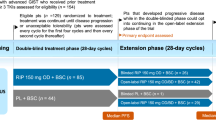Abstract
The chemotherapies of FOLFOX (leucovorin + 5-fluorouracil + oxaliplatin) and FOLFIRI (folinic acid + 5-fluorouracil + irinotecan) are effective for a variety of malignant tumors. In particular, the sequential chemotherapy of FOLFOX/FOLFIRI has become the preferred post-operational treatment approach for gastrointestinal cancer and an important palliative care program for advanced cancer. However, the sequential chemotherapy of FOLFOX/FOLFIRI showed severe side effects due to the fact that the toxicity of the drugs can be enhanced by each other. Here, we report the dynamic changes in the activities of serum ACTH, cortisol, renin, angiotensin, and aldosterone in patients following multiple cycles of FOLFOX/FOLFIRI sequential chemotherapy. We found that the sequential chemotherapy might cause damage to the activities of the endocrine cells and/or the sympathetic nerve, and alter endocrine function, specifically the ACTH–cortisol and renin–angiotensin–aldosterone axes.
Similar content being viewed by others
References
Donzelli E, Carfi M, Miloso M et al (2004) Neurotoxicity of platinum compounds: comparison of the effects of cisplatin and oxaliplatin on the human neuroblastoma cell line SH-SY5Y. J Neurooncol 67:65–73
Gamelin L, Boisdron-Celle M, Delva R et al (2004) Prevention of oxaliplatin-related neurotoxicity by calcium and magnesium infusions:a retrospective study of 161 patients receiving oxaliplatin combined with 5-fluorouracil and leucovorin for advanced colorectal cancer. Clin Cancer Res 10:4055–4061
Kristyanto H, Utomo AR (2010) Pharmacogenetic application in personalized cancer treatment. Acta Med Indones 42:109–115
Huang C, Chen L, Zhao J et al (2008) Influence of chemotherapy with FOLFOX protocoI on sex hormones of male patients and the protective effect of herbal medicines for reinforcing Shen and supplementing Qi on it. Chin J Integr Tradit West Med 28:136–138 (article in Chinese)
Huang C, Chen L, Zhao J et al (2008) Preventive effect of Zhenqifuzheng(贞 芪 扶 正) granules on chemotherapy-induced haematopoietic toxicity after colorectal cancer operation. Chin J Surg Integr Tradit West Med 14:441–446 (article in Chinese)
Donzelli E, Carfi M, Miloso M et al (2004) Neurotoxicity of platinum compounds: comparison of the effects of cisplatin and oxaliplatin on the human neuroblastoma cell line SH-SY5Y. J Neurooncol 67:65–73
Hwang BH, Guntz JM (1997) Down regulation of corticotrophin releasing factor mRNA, but not vasopressin mRNA, in the paraventricular hypothalamic nucleus of rats following nutritional stress. Brain Res Bull 43:509
Nakase S, Kitayama I, Soya H et al (1998) Increased expression of mango cellular arginine vasopressin mRNA in paraventricular nucleus of stress-induced depression-model rats. Life Sci 63:23
Marik PE, Zaloga GP (2002) Adrenal insufficiency in the critically ill: a new look at an old problem. Chest 122:1784–1796
Annane D, Sebille V, Charpentier C et al (2002) Effect of treatment with low doses of hydrocortisone and fludrocortisone on mortality in patients with septic shock. JAMA 288:862–871
Ligtenberg JJ, Zijlstra JG (2004) The relative adrenal insufficiency syndrome revisited: which patients will benefit form low-dose steroids? Curr Opin Crit Care 10:456–460
Kifor I, Moore TT, Fallo F (1991) The effect of sodium intake on angiotensin content of the rat adrenal grand. Endocrinology 128:1277–1284
Mial S, Loke KE, Slater JP et al (1999) Synergy of an lodipine and angiotensin converting enzyme inhibitors in regulating myocardial oxygen consumption in normal canine and failing human hearts. Am J Cardiol 83:92–98
Brown GC (1995) Nitric oxide regulates mitochondrial respiration and cell function by inhibiting cytochromeoxidase. FEBS Lett 369:136–139
Kerr DJ, Burt AD, Beastall GH, Holloway CD (1986) The effect of 5-fluorouracil on rat adrenal function. Med Oncol Tumor Pharmacother 3:101–104
Jensen SA, Hasbak P, Mortensen J, Sørensen JB (2010) Fluorouracil induces myocardial ischemia with increases of plasma brain natriuretic peptide and lactic acid but without dysfunction of left ventricle. J Clin Oncol 28:5280–5286
Damman J, Nijboer WN, Schuurs TA et al (2011) Local renal complement C3 induction by donor brain death is associated with reduced renal allograft function after transplantation. Nephrol Dial Transplant 26:2345–2354
Suzuki O, Ishii H, Kobayashi S (2011) Effects of an angiotensin 2 receptor blocker plus diuretic combination drug in chronic heart failure complicated by hypertension. J Int Med Res 39:1420–1426
Acknowledgements
We sincerely thank Professor XT Cao for his scientific help in this work. Also, we acknowledge Dr L.F. Zhou for technical assistance. This work was supported by grants from the National Natural Science Foundation of China (#30872380, #81072495), Program for Innovative Research Team in Zhejiang Province, China (#2010R50046), the Science and Technology Project of Zhejiang province, China (#2010C33006) and the Science and Technology Project of Hangzhou, China (20091233Q10). We acknowledge Siemens and Abbott for their pharmaceutical and industry support.
Author information
Authors and Affiliations
Corresponding author
Rights and permissions
About this article
Cite this article
Huang, C., Jiang, Y., Duan, G. et al. Effects of sequential chemotherapy of FOLFIRI/FOLFOX on the endocrine axes of ACTH–cortisol and renin–angiotensin–aldosterone. J Neurooncol 108, 485–490 (2012). https://doi.org/10.1007/s11060-012-0845-0
Received:
Accepted:
Published:
Issue Date:
DOI: https://doi.org/10.1007/s11060-012-0845-0




